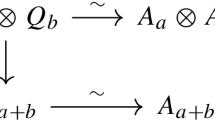Abstract
We construct a quadratic quantum algebra based on the dynamical \(RLL\)-relation for the quantum \(R\)-matrix related to \(SL(NM)\)-bundles with a nontrivial characteristic class over an elliptic curve. This \(R\)-matrix simultaneously generalizes the elliptic nondynamical Baxter–Belavin and the dynamical Felder \(R\)-matrices, and the obtained quadratic relations generalize both the Sklyanin algebra and the relations in the Felder–Tarasov–Varchenko elliptic quantum group, which are reproduced in the respective particular cases \(M=1\) and \(N=1\).
Similar content being viewed by others
References
R. J. Baxter, “Partition function of the Eight-Vertex lattice model,” Ann. Phys., 70, 193–228 (1972).
A. A. Belavin, “Dynamical symmetry of Integrable quantum systems,” Nucl. Phys. B, 180, 189–200 (1981).
E. K. Sklyanin, “Some algebraic structures connected with the Yang–Baxter equation,” Funct. Anal. Appl., 16, 263–270 (1982).
A. V. Odesskii and B. L. Feigin, “Sklyanin elliptic algebras,” Funct. Anal. Appl., 23, 207–214 (1989).
Y.-H. Quano and A. Fujii, “Generalized Sklyanin algebra,” Modern Phys. Lett. A, 6, 3635–3640 (1991).
A. V. Zotov, A. M. Levin, M. A. Olshanetsky, and Yu. B. Chernyakov, “Quadratic algebras related to elliptic curves,” Theoret. and Math. Phys., 156, 1103–1122 (2008), arXiv:0710.1072; H. W. Braden, V. A. Dolgushev, M. A. Olshanetsky, and A. V. Zotov, “Classical \(r\)-matrices and the Feigin–Odesskii algebra via Hamiltonian and Poisson reductions,” J. Phys. A: Math. Gen., 36, 6979–7000 (2003), arXiv:hep-th/0301121; B. Khesin, A. Levin, and M. Olshanetsky, “Bihamiltonian structures and quadratic algebras in hydrodynamics and on non-commutative torus,” Commun. Math. Phys., 250, 581–612 (2004), arXiv:nlin/0309017 [nlin.SI].
G. Felder, “Conformal field theory and integrable systems associated with elliptic curves,” in: Proceedings of the International Congress of Mathematicians (Zürich, Switzerland, August 3–11, 1994), Vols. 1, 2 (S. D. Chatterji, ed.), Birkhäuser, Basel (1995), pp. 1247–1255; G. Felder and A. Varchenko, “Elliptic quantum groups and Ruijsenaars models,” J. Stat. Phys., 89, 963–980 (1997), arXiv:q-alg/9704005.
V. O. Tarasov and A. N. Varchenko, “Small elliptic quantum group \(e_{\tau,\gamma}(\mathfrak{sl}_N)\),” Mosc. Math. J., 1, 243–286 (2001); arXiv:math/0011145 [math.QA].
A. Levin, M. Olshanetsky, A. Smirnov, and A. Zotov, “Characteristic classes of \(SL(N,\mathbb C)\)-bundles and quantum dynamical elliptic \(R\)-matrices,” J. Phys. A: Math. Theor., 46, 035201, 25 pp. (2013), arXiv:1208.5750; A. V. Zotov and A. V. Smirnov, “Modifications of bundles, elliptic integrable systems, and related problems,” Theoret. and Math. Phys., 177, 1281–1338 (2013); I. A. Sechin and A. V. Zotov, “\({\rm GL}_{NM}\) quantum dynamical \(R\)-matrix based on solution of the associative Yang–Baxter equation,” Russian Math. Surveys, 74, 767–769 (2019).
I. Sechin and A. Zotov, “\(R\)-matrix-valued Lax pairs and long-range spin chains,” Phys. Lett. B, 781, 1–7 (2018), arXiv:1801.08908; A. Grekov and A. Zotov, “On \(R\)-matrix valued Lax pairs for Calogero–Moser models,” J. Phys. A, 51, 315202, 26 pp. (2018), arXiv:1801.00245; A. Grekov, I. Sechin, and A. Zotov, “Generalized model of interacting integrable tops,” JHEP, 10, 081, 32 pp. (2019), arXiv:1905.07820.
A. V. Zotov, “Relativistic interacting integrable elliptic tops,” Theoret. and Math. Phys., 201, 1565–1580 (2019), arXiv:1910.0824; I. A. Sechin and A. V. Zotov, “Integrable system of generalized relativistic interacting tops,” Theoret. and Math. Phys., 205, 1291–1302 (2020), arXiv:2011.09599.
Funding
This research is supported by a grant from the Russian Science Foundation (Project No. 21-41-09011).
Author information
Authors and Affiliations
Corresponding author
Ethics declarations
The authors declare no conflicts of interest.
Additional information
Translated from Teoreticheskaya i Matematicheskaya Fizika, 2021, Vol. 208, pp. 355-364 https://doi.org/10.4213/tmf10100.
Appendix A. Elliptic functions and their properties
In the definitions of \(R\)-matrices in this paper, we use the Kronecker elliptic functions
The main tool for the derivation of the quadratic relations is the addition formula (also known as the genus-one Fay identity) for the Kronecker functions
Appendix B. An example of calculation verifying the $$RLL$$ -relation
We consider, for example, the \((E_{ij})_a(E_{ik})_b\)-component of the \(RLL\)-relation:
Rights and permissions
About this article
Cite this article
Sechin, I.A., Zotov, A.V. Quadratic algebras based on \(SL(NM)\) elliptic quantum \(R\)-matrices. Theor Math Phys 208, 1156–1164 (2021). https://doi.org/10.1134/S0040577921080110
Received:
Revised:
Accepted:
Published:
Issue Date:
DOI: https://doi.org/10.1134/S0040577921080110



